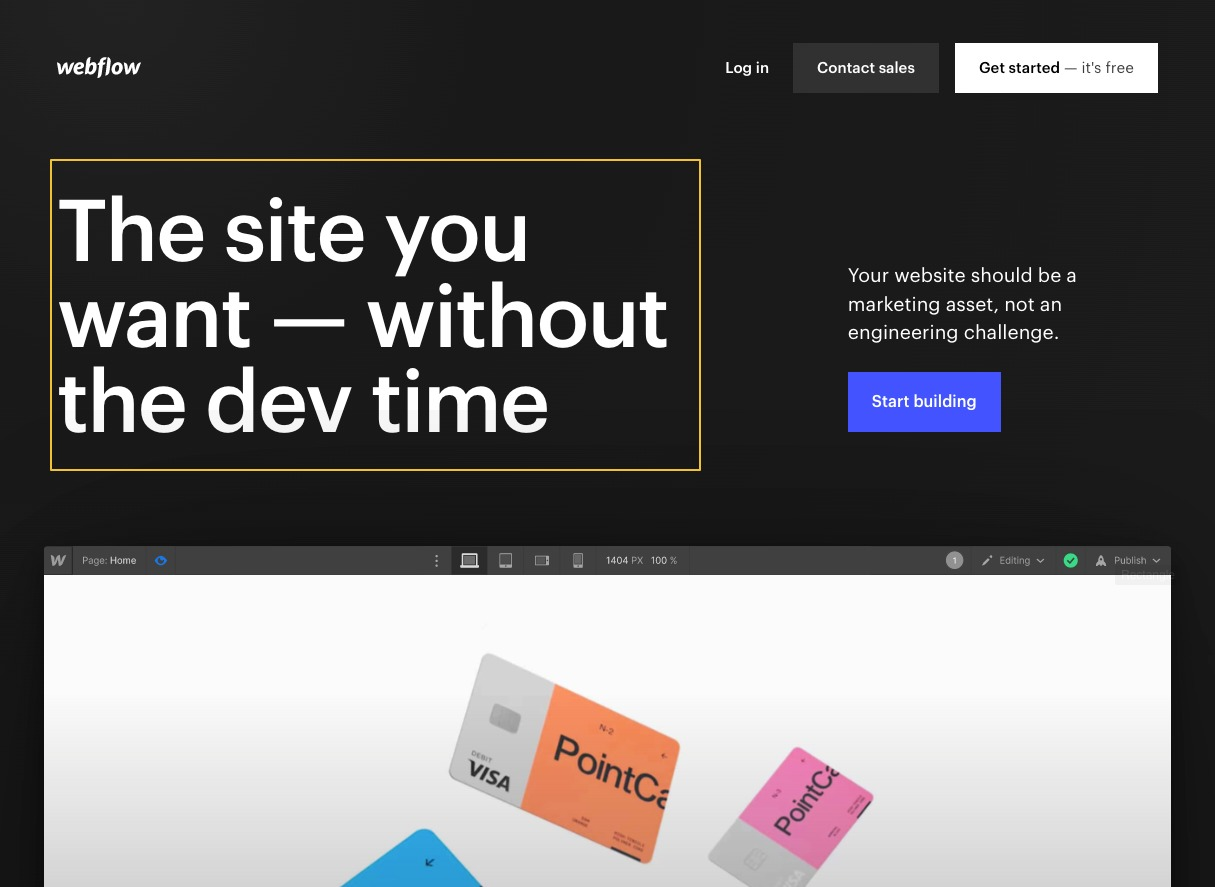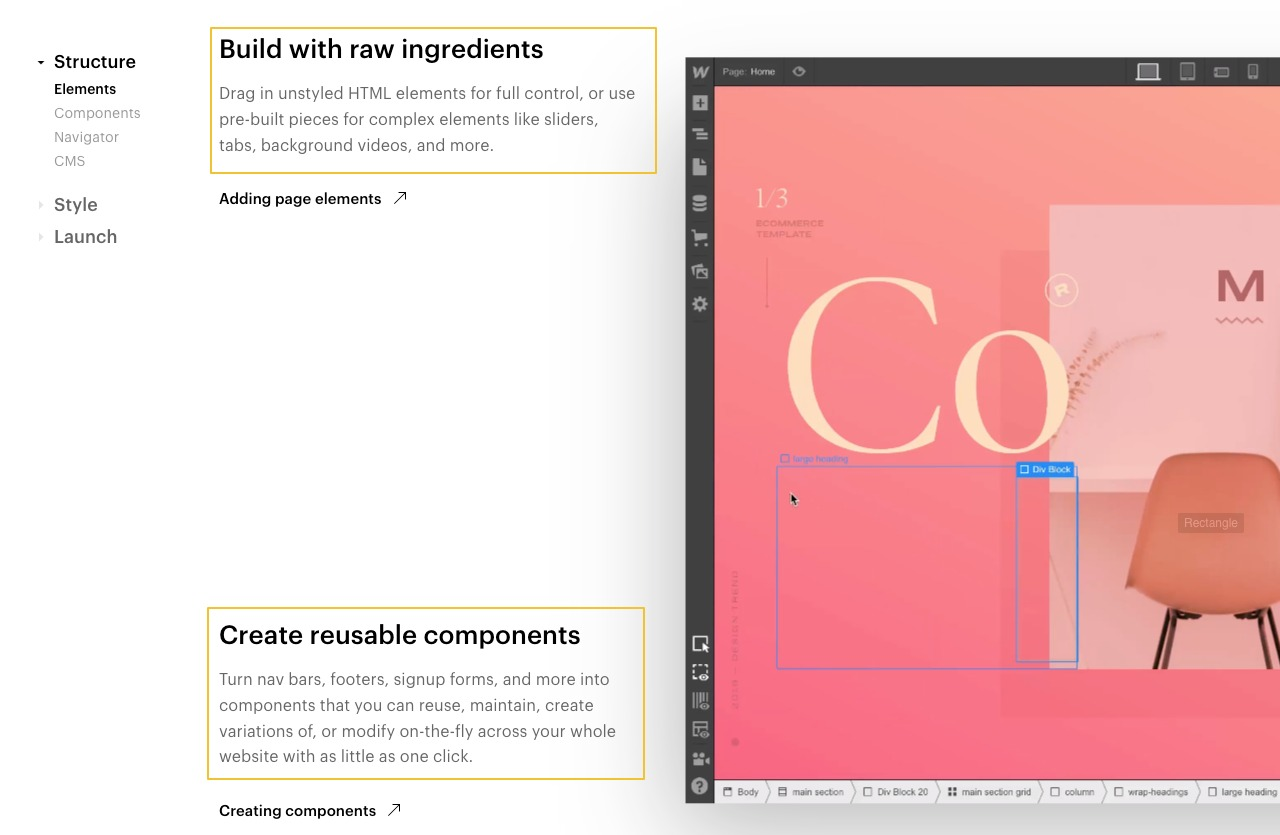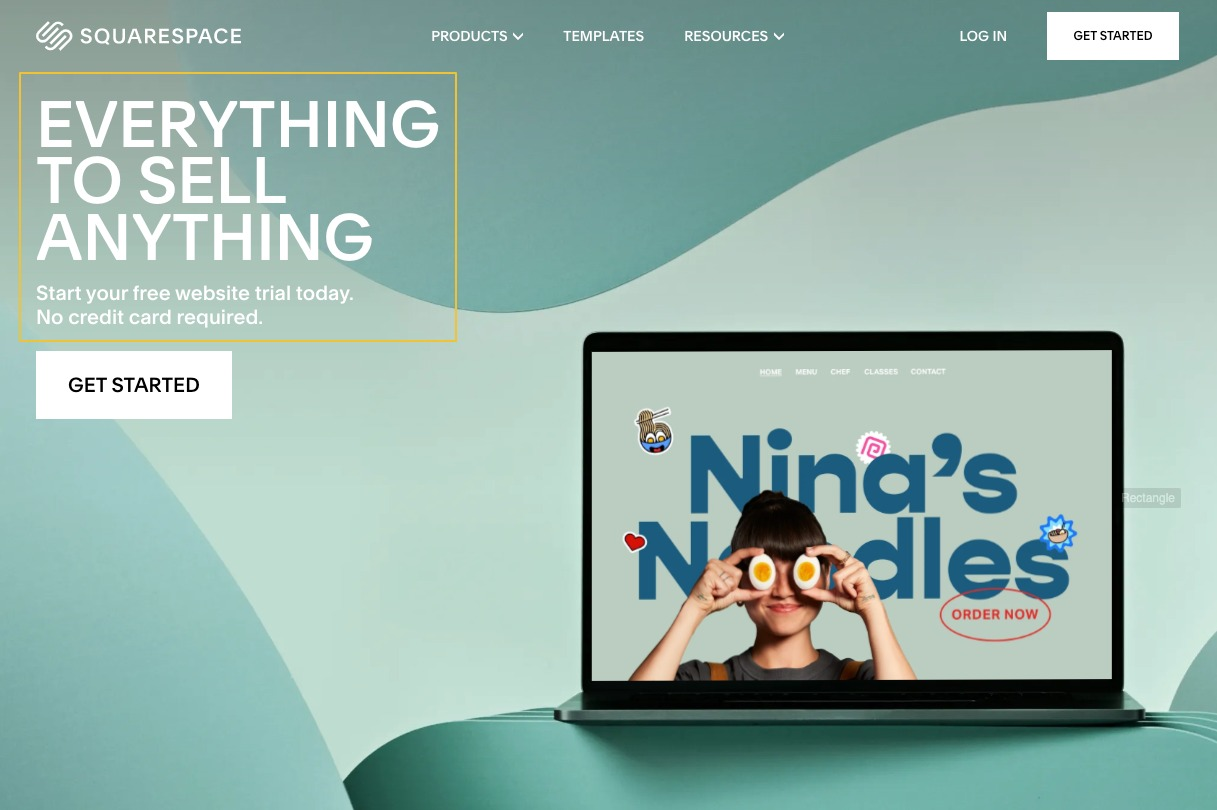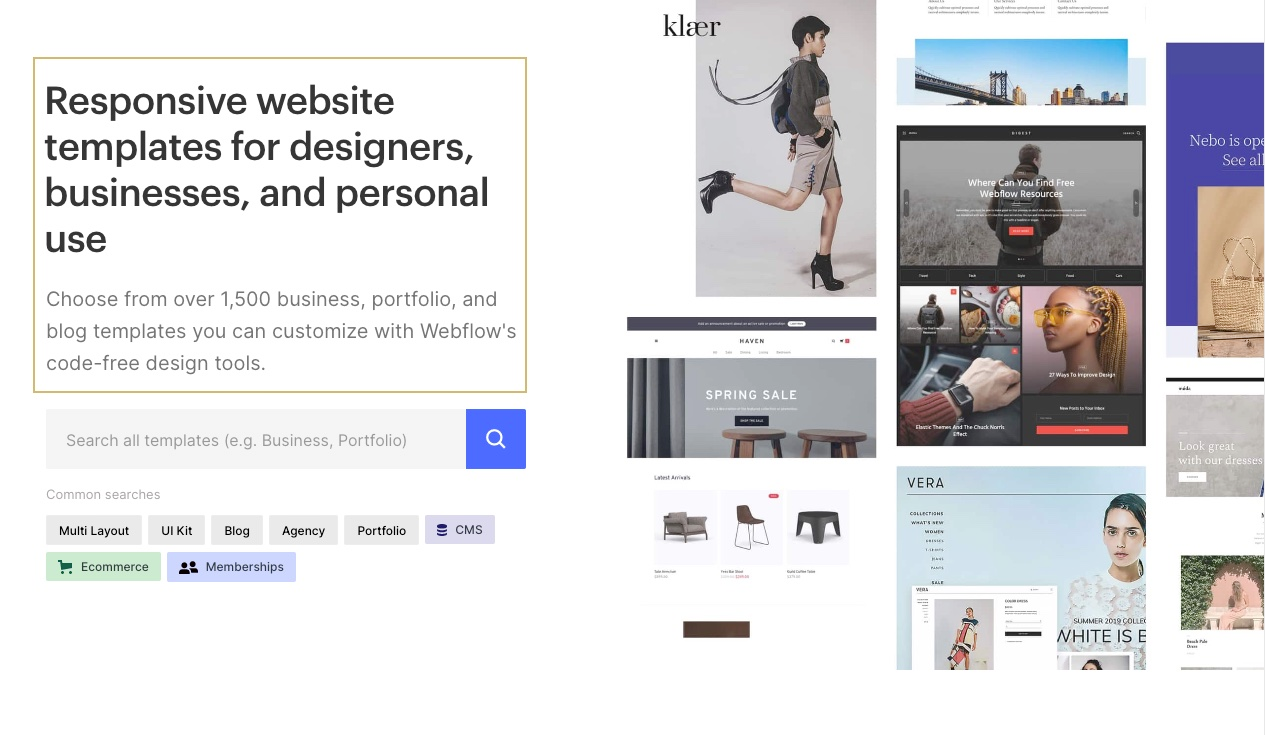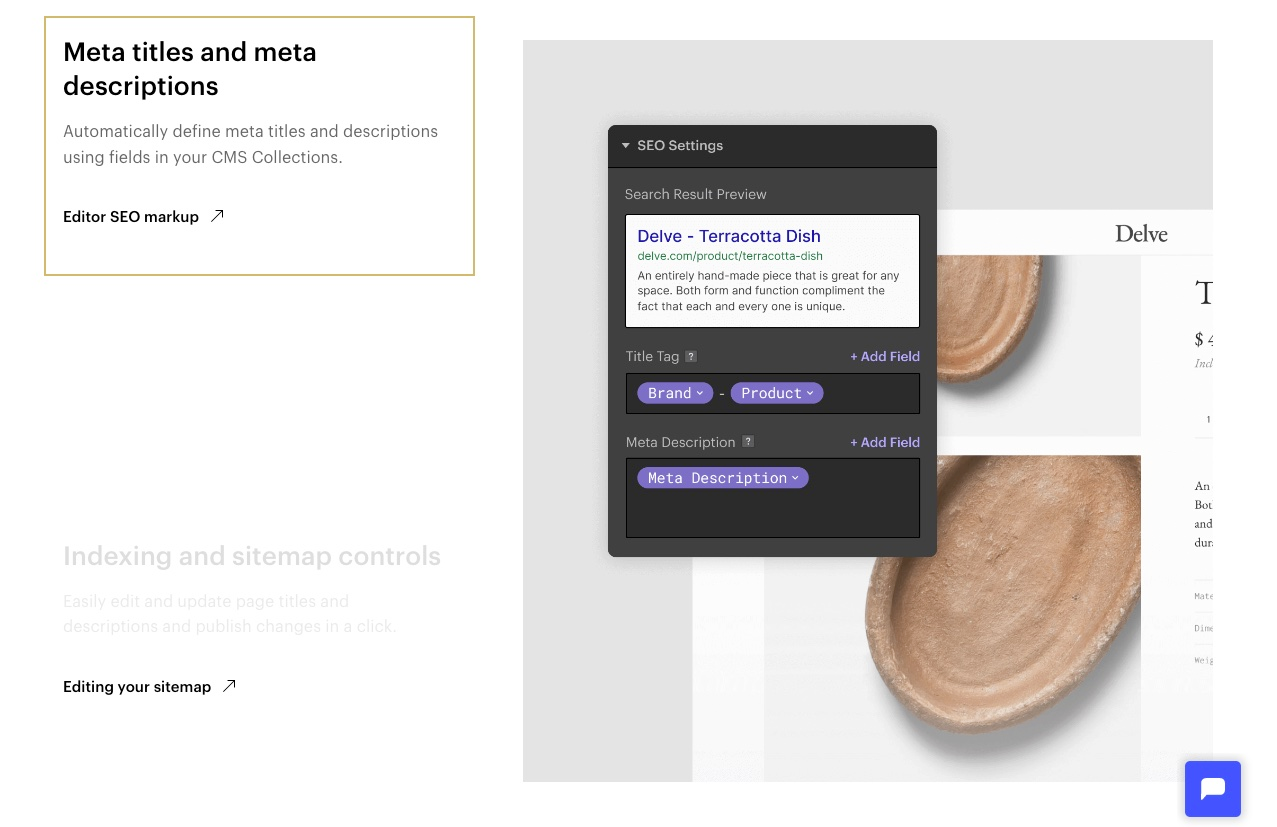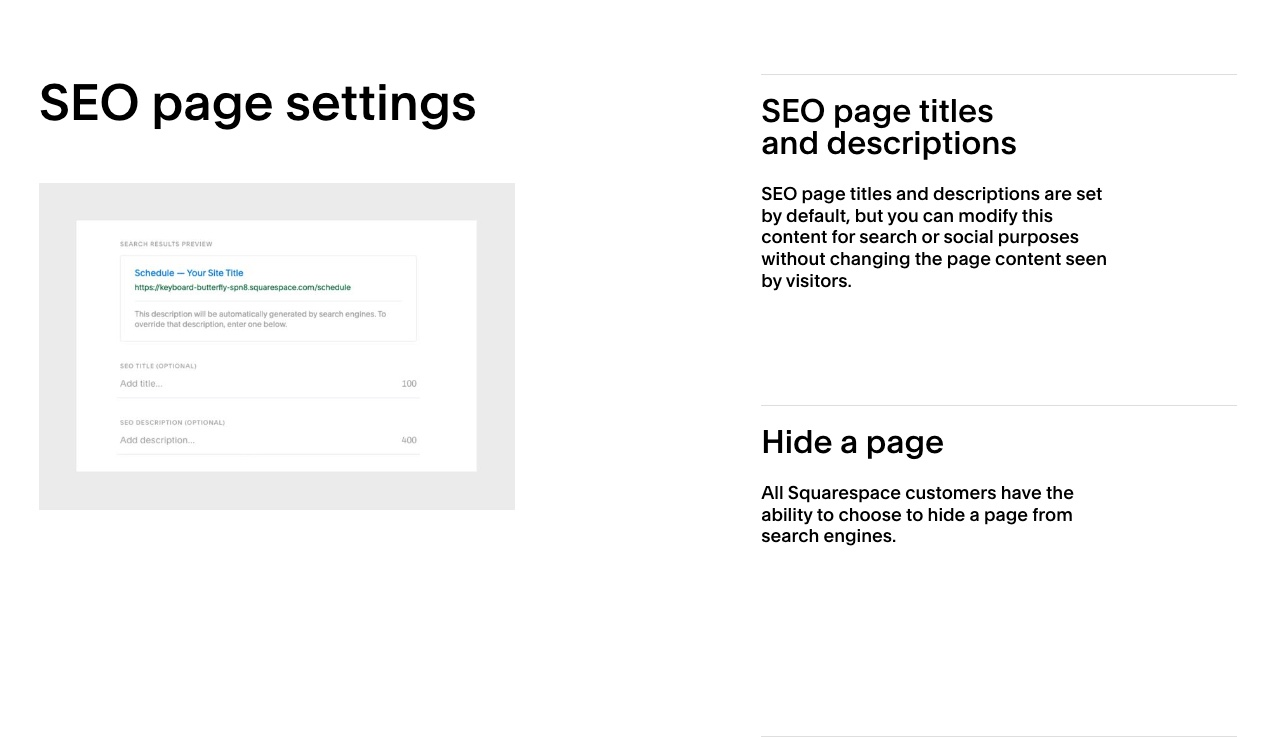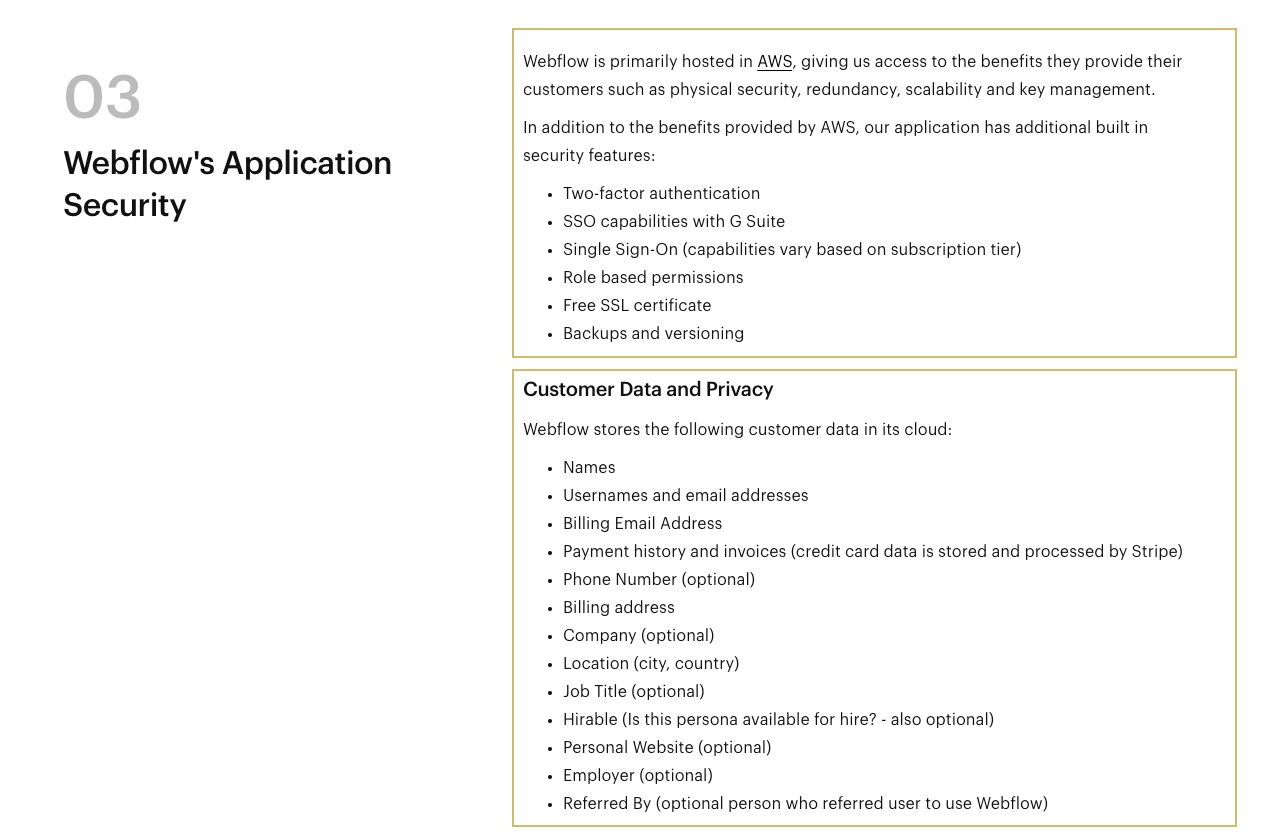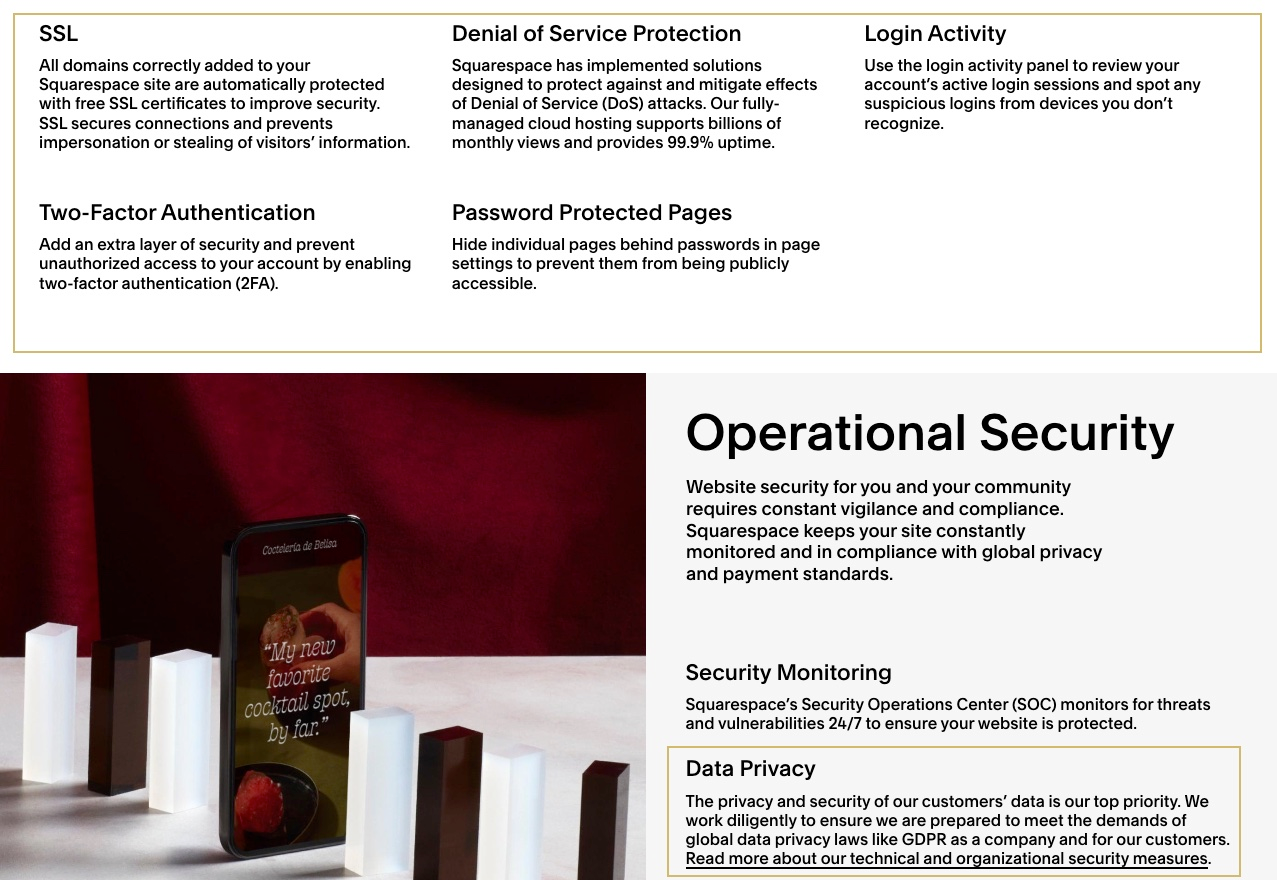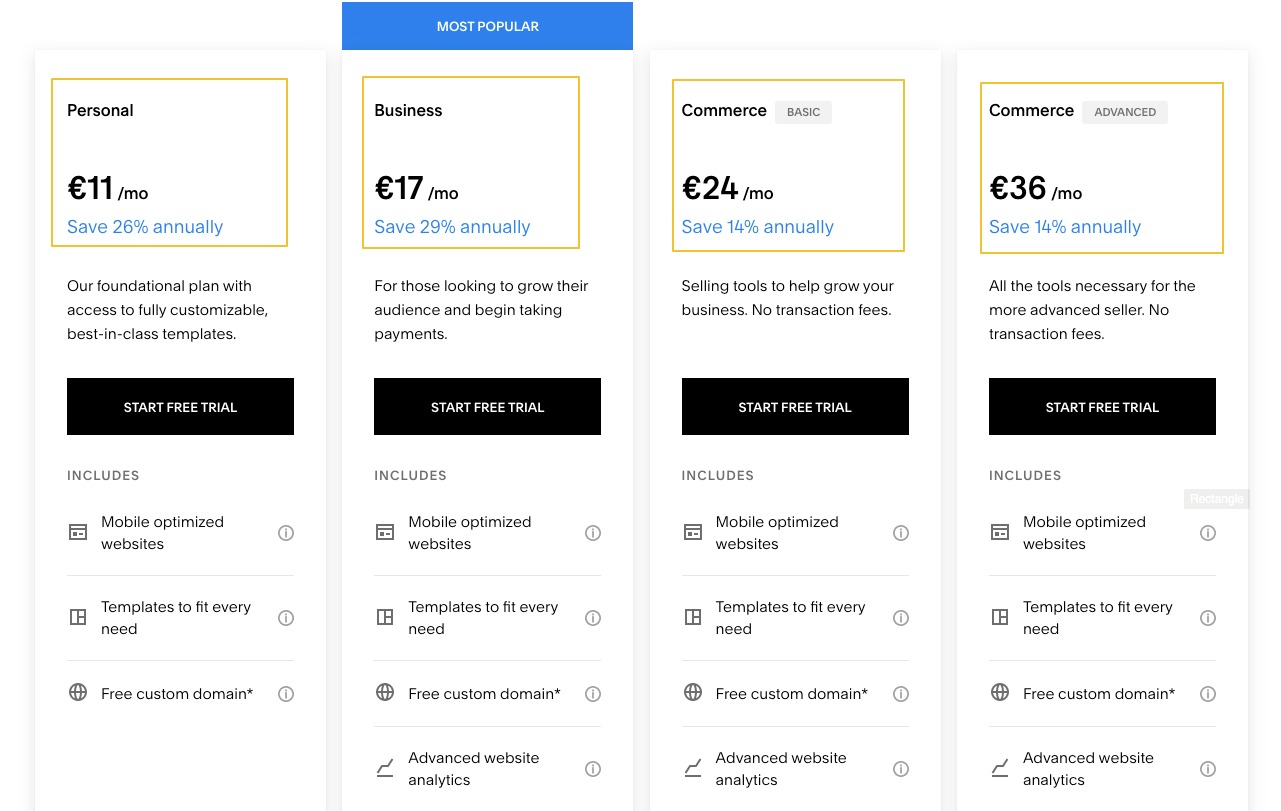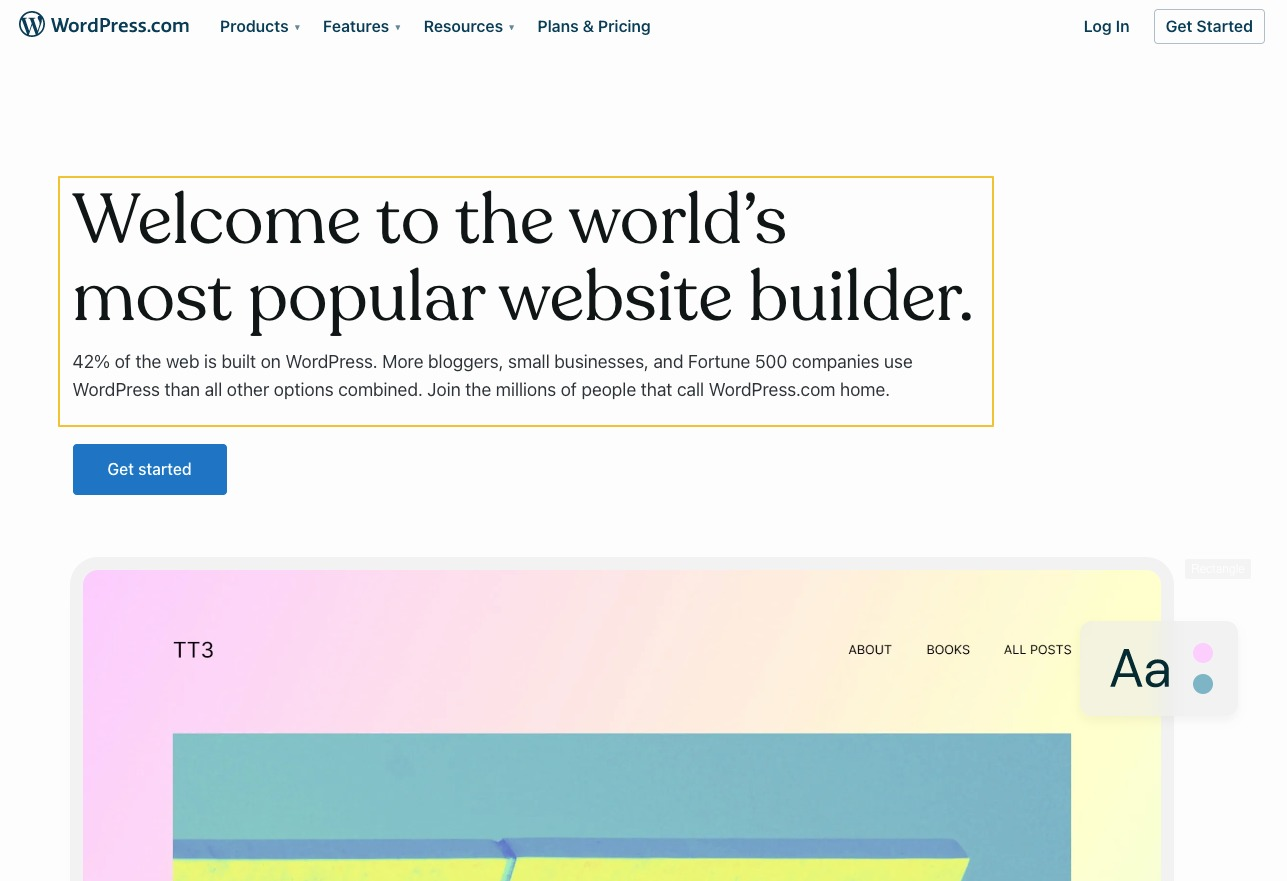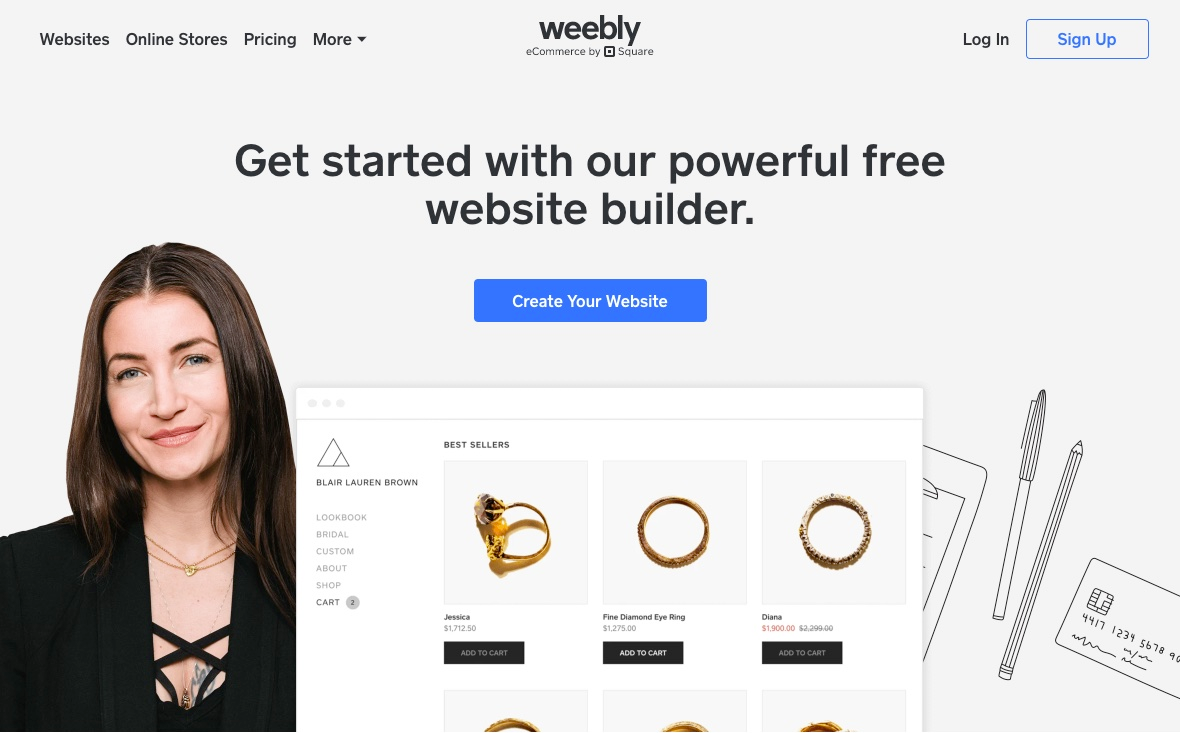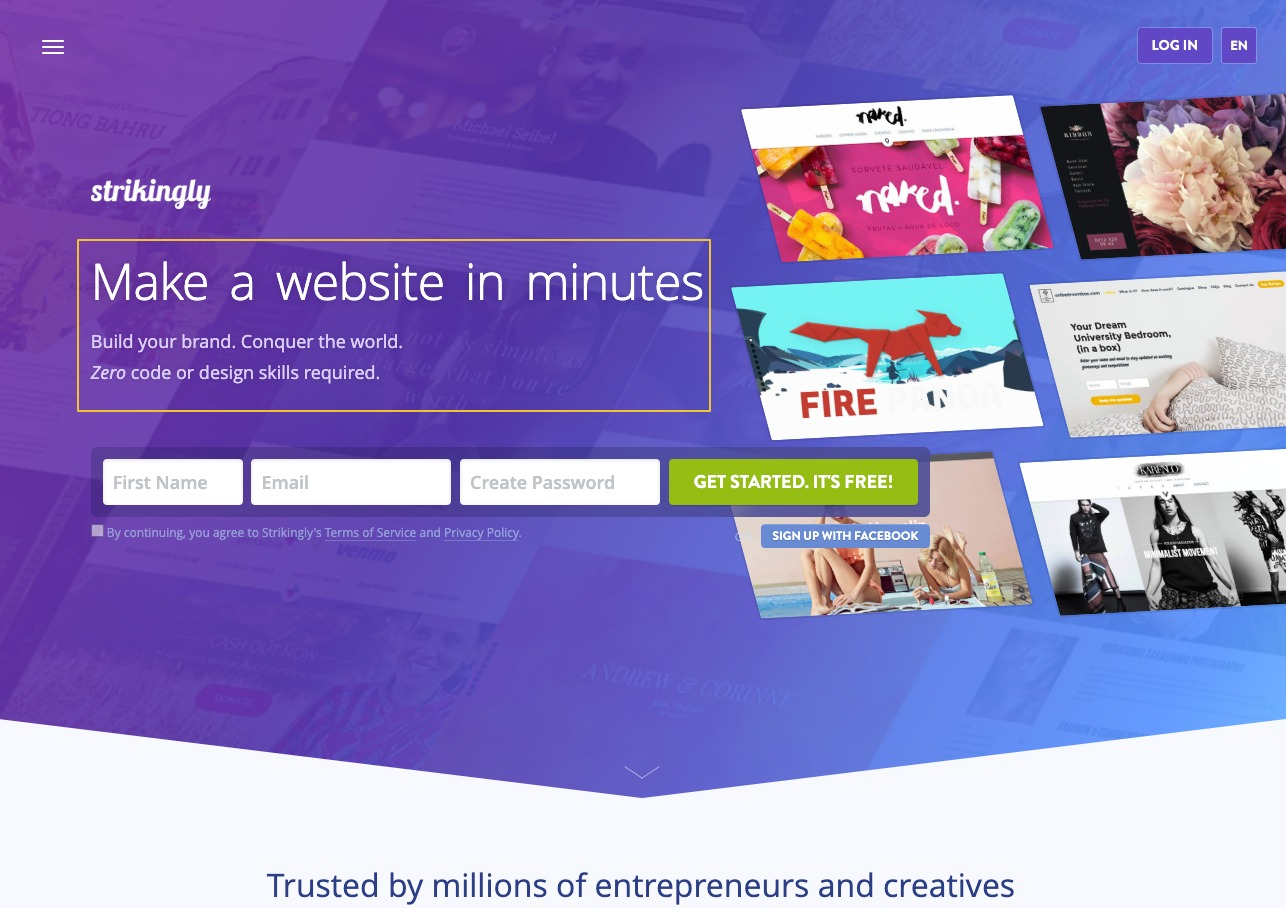Webflow vs. Squarespace: Two Different Platforms & Results

Table of Contents
If you’re having trouble deciding between Webflow and Squarespace, you’re in the right place. Webflow and Squarespace are popular platforms for building websites, and each has its own unique set of features.
Webflow is a visual drag-and-drop editor that lets you create custom responsive websites without writing code, even though it has that option if you choose.
Squarespace is a popular all-in-one platform that provides everything you need to create a professional website, including hosting, templates, and e-commerce features.
In this article, we’ll compare Webflow vs. Squarespace feature by feature to help you decide which one is right for you.
What Is Webflow?
Webflow is a web design platform that allows users to create responsive websites without coding. Their vision is to build the world’s most powerful no-code development platform.
Webflow makes your website your biggest marketing asset by allowing you to quickly and easily create responsive web pages that look awesome on any device. Vlad Magdalin, Sergie Magdalin, and Bryant Chou founded Webflow in 2013.
What Does Webflow Do?
Webflow provides a drag-and-drop visual editor for creating responsive websites. It generates clean, semantic code that you can export to any hosting provider. Webflow also offers e-commerce features, form builders, and CMS integrations.
It’s an all-in-one platform that provides everything you need to create a website. Webflow offers large businesses enterprise features, such as white-labeling, role-based access control, and password protection.
How Does Webflow Work?
Building a website on Webflow isn’t as straightforward compared to Squarespace. The platform comprises several individual products and features, each representing one aspect of the system: Designer, CMS, and e-commerce. Let’s take a look at each one.
Designer
The designer tool is where you will create your website. It’s a visual editor that lets you add and style elements on your page without writing code. The designer tool converts your design into HTML, CSS, and JavaScript. It works best for prototypers and designers who want to create custom responsive designs. However, they recommend combining the designer and CMS if you make a completely custom website.
CMS
The CMS is where you will manage your website’s content. With the CMS, you can add and edit pages, blog posts, products, collections, and more. The CMS gets powered by a database that stores your content. Once you publish your site, the CMS generates HTML, CSS, and JavaScript files to display your website content.
E-commerce
E-commerce features allow you to sell products on your website. With E-commerce, you can:
Add products
Set up payments
Manage order
E-commerce is a paid feature, so you will need to upgrade to a paid plan to use it.
Hosting
Amazon Web Services provides the hosting for all Webflow sites. They offer a CDN (Content Delivery Network) that speeds up the delivery of your site’s content to visitors around the world.
Once you’ve decided whether you want to use the designer tool, CMS, e-commerce, or all three, the following step is creating a homepage.
Creating a Homepage
When you first create a project in Webflow, it comes with a pre-built homepage template. It’s a good starting point if you want to get a feel for how the platform works. If you’re unhappy with the pre-built template, you can start from scratch or use one of the many templates available in Webflow.
When you’re designing your homepage, you’ll be able to add and style elements on the page. You can also use responsive views to see how your site will look on different devices. You’ll notice immediately that the process of creating a website in Webflow takes longer, requires more attention to detail, and is more complex than using Squarespace.
But, with that extra time and effort comes much more control over the final product.
Is Webflow a CMS?
Webflow technically isn’t a CMS. Instead, it gives you the option to use their CMS product which is a headless CMS or a content management system that doesn’t have a front end. It means that you can use the CMS to manage your content, but you’ll need to combine it with the designer and e-commerce if you want to create an online store.
What Is Squarespace?
Squarespace is another popular website builder that allows users to create beautiful websites without coding. Anthony Casalena founded Squarespace in 2003 to turn an idea into a published website in less than an hour.
What Does Squarespace Do?
What does Squarespace do? With Squarespace, creating a professional website becomes a straightforward process.
Their platform includes templates, hosting, e-commerce features, and 24/7 customer support. Squarespace hosts your website for you and provides you with everything you need to create a professional website. The platform is a fantastic choice for users who want a simple, one-stop-shop platform for building a personal website on Squarespace.
How Does Squarespace Work?
How does Squarespace work? Put simply, Squarespace is a drag-and-drop webpage builder. Users transform templates into beautiful websites without having any coding experience.
You can start by selecting a template. Squarespace offers a wide variety of templates for different types of websites, so you can find one that fits your specific needs.
You will also need a custom domain name to use Squarespace. Once you have a domain name, it’s time to begin customizing your site. Add your content, customize the templates to match your branding kit, and add pictures to your content. This effortless process makes it easy for anyone to create a beautiful website.
The next step is to promote your site. The best place to start with marketing is social media. Add links to your social accounts and start sharing your content. You can also use Squarespace’s email marketing tools to reach a wider audience. With any site, success comes with consistency. Be sure to keep your site up-to-date with new content, products, and services.
Is Squarespace a CMS?
No, Squarespace isn’t a CMS. But Squarespace is a simple yet robust website builder that allows you to create any website you want, whether you know how to code or aren’t tech-savvy.
While you can add content to Squarespace sites, they don’t offer the same level of content management as a CMS. Squarespace works as a beginner-friendly platform for those wanting a website to showcase their content and products yesterday.
Squarespace vs. Webflow Features
Both platforms offer tons of features for their clients. Let’s take a look at some of the features that each platform provides to consider how Squarespace vs. Webflow measures up.
Templates
Webflow has over 400 templates to choose from. Customize each template to fit your needs. Some templates include:
Blog
Agency
Designer
One page
Photography
Portfolio website
Every template has a code-free responsive design that looks great on any device.
You may also adjust the ordering of items in a collection using Webflow’s collection template page, which generates automatically. The collection template page then applies to each item in the group, allowing you to create hundreds or thousands of pages at once by simply modifying how it appears.
Squarespace also has a wide selection of templates to choose from. They offer over 100 free templates, and their templates provide flexibility. Every template design lets you customize it to match your brand.
Every template Squarespace offers supports all the major content types you might want, like pages, galleries, blogs, commerce items, calendars, and more.
You don’t need to stress about whether or not people will be able to view your site on their browsers or mobile devices either because the designs get created with those components in mind. Squarespace employs only the latest HTML CSS Javascript techniques as well.
While Webflow offers more in terms of quantity, Squarespace’s templates make it much easier to create websites. Customers can even add more sections or pages without losing branding fonts, colors, and logos.
The major difference here is that Webflow lets you edit even the most intricate details of your site while still being code-free. While this gives you complete control of your website’s appearance, it can create problems for those less tech-savvy.
Also, Squarespace offers all of its templates for free. Specific templates require an extra purchase with Webflow, which we will get into later when we discuss pricing and plans.
Marketing and SEO
Marketing and SEO are essential for any website. Both platforms offer a wide variety of marketing and SEO features to help you get your website seen by the right people.
Both platforms offer alt tags to images, automatically generated sitemap, and mobile optimization. Webflow also provides support for:
Custom meta tags
Google Analytics
Custom 404 pages
You can also link to social media accounts and embed social posts on your site, which increases engagement.
Webflow has a visual CMS, which is ideal for those who don’t want to code. You can easily add, delete, or edit the website content without touching a single line of code.
Squarespace incorporates all of the SEO best practices without the need for any extra plugins.
While both platforms offer a wide variety of marketing and SEO features, Webflow provides more features, such as custom meta tags and support for Google Analytics.
Integrations
Webflow integrates with Google Analytics and Google Domains, making tracking your website’s traffic and managing your domains easy.
You can also integrate Webflow with MailChimp, making managing your email list and sending out newsletters a breeze.
Webflow also integrates with Google Optimize, which lets you run A/B tests on your website. It is a superb way to test different versions of your website to see what works best for your visitors.
Squarespace makes it easy for you to run your business in one place by integrating with:
Apple Pay
PayPal
Stripe
Square
Google Analytics
MailChimp
You can also use the developer platform to create custom integrations with any other services you need.
Both platforms partner with Zapier. Zapier lets you connect two different apps and automate tasks. For example, you can automatically use Zapier to add new Squarespace customers to your MailChimp mailing list.
Both platforms offer helpful integrations to make managing your website more accessible. Squarespace offers more integrations out of the box, making it ideal for those running an e-commerce store or who need to accept online payments.
Security and Privacy
Webflow gets hosted by AWS. AWS offers customers physical security, scalability, and key management. All of these features are critical when it comes to safety.
In addition, clients can further secure their site with a free SSL certificate and two-factor authentication. Some other notable security features include:
SSO capabilities with G Suite
Backups and versioning
Role-based permissions
Squarespace offers customers a free SSL certificate that shows your website is secure and encrypted. Your online store must give customers peace of mind that their information is safe.
All Squarespace websites get hosted on our secure servers, which means your website is always safe and backed up. You never have to worry about losing your content or even getting hacked.
Both platforms give customers security features. However, Webflow offers customers more control over their website with features, such as SSO and role-based permissions.
Customer Branding
Webflow offers white labeling for those who want to rebrand their Webflow site as their own. This option is a great feature for agencies who wish to put their own spin on things.
Squarespace also offers white labeling for those who want to rebrand their Squarespace site as their own. However, they offer an unfold brand kit that lets you upload logos, colors, fonts, and stickers to keep your branding consistent across your pages.
Both platforms offer white labeling. However, Squarespace goes a step further by also offering a brand kit.
Support
Having support when building your website is crucial. Webflow offers support through its knowledge base, community forum, and live chat. The community forum houses thousands of Webflow users that share tips, tricks, common problems, and solutions.
Those who subscribe to their pro, team, or enterprise plans get priority support. Whenever a problem arises, contact them, and your inquiry automatically gets put at the front of the queue. They also offer training courses and webinars to help you build your website.
Squarespace offers a community forum as well as 24/7 email and chat support. You can join one of their live webinars or take a self-paced Squarespace education course. They offer various video tutorials to help you build your website.
Both platforms offer support from thorough knowledge bases, community forums, live chat, and email. However, Squarespace offers 24/7 support, while Webflow only provides priority support to those on a paid plan.
Pricing and Plans
In today’s world, customers look for a program that offers them the most bang for their buck. Let’s look at all the plans that both platforms offer.
Webflow Pricing Breakdown
Overall, Webflow offers more plans and greater plan customization. On the platform, both site plans and e-commerce plans are available.
The site plans work best for more simple or content-driven sites. The e-commerce plans are for those who want to build an online store. All of the programs give you access to the Webflow Designer. Let’s start with the five site plans
Starter Plan
The starter plan is free until you get more than 1,000 monthly visitors. It comes equipped with 1 GB of bandwidth and a 50 CMS block limit.
Basic Plan
The basic membership costs $15 per month and has 50 GB of storage and 25,000 monthly visits. Unfortunately, it doesn’t come with CMS.
CMS Plan
The CMS plan features 2,000 CMS items and 200 GB bandwidth, and three guest editors. With this $20 per month membership, clients have 100,000 monthly visits.
Business Plan
The $45 business plan gives customers up to 250,000 monthly visits, ten guest editors, 400 GB of bandwidth, and up to 10,000 CMS items.
Enterprise Plan
Lastly, the Enterprise plan offers up to 10,000 CMS items. Outside of that, clients will have to contact the sales representatives of Webflow to create a customized plan.
Webflow also offers three e-commerce plans as described below.
Standard Plan
With the standard membership, you can have up to 500 items and earn up to $50,000 per year. However, Webflow earns two percent off of each sale you accrue. The price for the standard plan is $29 each month.
Plus Plan
The plus membership tier costs $74 per month and lets customers host up to 1000 items and earn up to $200,000 per year. Customers don’t pay transaction fees with this plan.
Advanced Plan
The advanced plan costs $212 per month. Customers who select this tier can host up to 3000 items and make unlimited sales without worrying about paying transaction fees.
Webflow will notify you to discuss the next steps if you go over any of the specified limits. Customers who opt for yearly billing can save up to 32 percent.
Squarespace Pricing Breakdown
Squarespace offers four pricing plans as described below.
Personal Plan
The personal plan gives customers access to the Squarespace video studio app, along with:
Unlimited bandwidth
A Free custom domain
Video storage
Extensions
Basic website metrics
The Squarespace video studio app is excellent for creating professional-quality videos. You can create how-to videos, product demonstrations, or even short films.
The app is free to use, and you can create an unlimited number of videos. Customers can also access SEO features and mobile optimization for better site visibility. The plan grants access to two contributors. You can get all this for $23 per month.
Business Plan
The business plan is a monthly payment of $33. This plan included all the features offered in the above option. But it also includes additional features, such as:
Unlimited site contributors
Complete customization with JavaScript and CSS
Professional email from Google
Premium blocks and integrations
CSS and JavaScript, in particular, can help turn a simple website into something more complex.
Regarding marketing, clients can take advantage of advanced site analytics, Google Ads credits, and promotional banners and pop-ups.
The business plan has an e-commerce store that’s fully integrated with a three percent transaction fee. With this plan, you can sell unlimited gift cards and products. One thing that makes the business plan stand out is that customers can accept donations.
Basic Commerce Plan
The basic commerce membership gives customers access to more streamlined e-commerce features. For one, it doesn’t have any transaction fees.
The plan stands out from the others because it offers point-of-sale transactions, product reviews, customer accounts, more robust analytics, and products on Instagram.
The powerful merchandising tools help customers sell smarter. Limited availability labels can also be added to products that are selling out to create urgency. The plan costs $36 per month.
Advanced Commerce Plan
The advanced commerce plan gives customers access to abandoned cart recovery, sell subscriptions, and advanced shipping and discounts. The membership works well for customers who want to take their business to the next level. The plan costs $65 per month and includes everything the basic commerce membership offers.
If you opt to pay your subscription using the annual plan instead of monthly, you can save up to 30 percent on subscriptions.
Pricing Comparison
While both Squarespace and Webflow offer great features, it depends on what you’re looking for in a web builder. If you need something simple and easy to use, Squarespace might be the better option. Squarespace lets you combine e-commerce and content marketing tools in one place.
If you’re looking for something with more detailed and customizable features, Webflow might be a better fit. Webflow separates content marketing and e-commerce, giving you more control over each aspect.
Both platforms offer great features and it comes down to what you need for your website.
Pros & Cons
Let’s analyze some pros and cons of Webflow vs. Squarespace.
Squarespace Pros
User-friendly platform
All-in-one platform for e-commerce and content marketing
No transaction fees for e-commerce plans
Discounts for annual plans
Squarespace Cons
Limited customization options
No phone support
Webflow Pros
More customization and control over website design
Separate e-commerce and content marketing platforms
Affordable monthly and annual plans
Discounts for annual plans
Webflow Cons
More complex platform than Squarespace
Transaction fees for e-commerce plans
No support priority support on free plans
If you need something more beginner-friendly, Squarespace might be the better option. Squarespace not only lets you combine e-commerce and content marketing in one place, but it doesn’t require you to think very much about how your final website will look. The templates come complete, and all you have to do is input your content.
Webflow, on the other hand, gives you more control over the design of your website. For those who aren’t tech-savvy and want a professional-looking site in less time, Webflow may not be the best option. However, for those who don’t mind a minor challenge and want more control over their website, Webflow is an incredible platform.
The pricing for each platform also varies. Webflow offers a free plan. Not to mention their basic plan only costs $15. Squarespace’s basic plan comes in at $23. Outside of that, Webflow costs more than Squarespace.
Who Each Platform Is Best Suited For
Squarespace is best suited for those who need an all-in-one platform for content marketing and e-commerce. The platform is user-friendly and great for beginners. Squarespace provides a terrific option for photographers, artists, and other creative professionals to showcase their work.
Even bloggers and small businesses can find Squarespace easy to use. It gives them all the tools they need in one place to create a stunning website that stands out from the crowd.
On the other hand, Webflow is suited for those who want more customization and control over their web design. The platform is more complex but gives users a lot of power to create a truly unique website. Webflow is a fantastic platform for web designers and developers who want to create custom websites for their clients.
It’s also an incredible option for businesses needing a more complex website than Squarespace offers. Webflow also works best with the bigger budgets of larger businesses, as the monthly fees can add up.
No matter which platform you end up with, you can create a beautiful and professional website. It depends on what you need and wants for your website. Consider your budget, level of expertise, and what you want to use your website for before making a decision.
Picking the Right Platform for You
To pick the platform that’s best suited to your business, think about the following:
Consider what your needs are.
Figure out your budget on money and time, and see which platform can give you what you need while staying within those parameters.
Test out Webflow’s free membership tier or Squarespace’s 14-day free trial.
Alternatives
If you aren’t sold on Squarespace or Webflow, you can consider a few other options.
Wix
Wix is another user-friendly platform that’s great for beginners. Wix is free to use but has limited features and customization options. The platform lets you design a website from scratch or use one of its many templates. Wix also has an all-in-one platform for e-commerce and content marketing.
Not to mention, you can optimize your site for search engines by simply asking a few questions. With Wix, you can generate a website in six simple steps. All you have to do is sign up for the platform and choose a template. Then use the easy drag-and-drop editor to add your content and customize your site.
You can also use Wix ADI (Artificial Design Intelligence) to create a website for you. After you add your features, input your online store information, and add your content, you can publish. All that’s remaining for you to do after publishing is to drive traffic to the site.
Wix works for those who don’t know code, don’t have time to build a website, or want an all-in-one platform for content marketing and e-commerce. However, it still works for those who know how to code.
You can also use Velo by Wix to create custom applications for your site. Velo works by letting you code in the Wix Editor.
WordPress
WordPress is a popular open-source platform suitable for anything from a simple blog to a complex website. WordPress is completely customizable, and there are no limits to what you can do with the platform. You can use WordPress for e-commerce, content marketing, and more.
Use one of their available themes or pick one to upload. You can also create your own custom theme with WordPress. If you’re not a coder, don’t worry. There are various themes and plugins available that don’t require any code. Not to mention, WordPress is free to use. You’ll just have to pay for hosting and a domain name.
Hosting can cost as little as $10 per month. Domains usually cost between $10 and $20 per year. One downside to WordPress is that it can be slow and susceptible to security threats. Another downside to WordPress is that it can be tricky for beginners to get the hang of.
If you’re unfamiliar with code, you’ll need to hire a WordPress developer to help you create and customize your website. WordPress is a high-quality option for those who need a completely custom website.
Weebly
Weebly is another user-friendly platform that is great for small businesses and entrepreneurs. Weebly has all you need to create a professional website. The platform is straightforward to use, and you can create a website in minutes. Weebly also has an all-in-one platform for e-commerce and content marketing.
The dashboard is streamlined, and you can drag and drop elements to create a custom website. Weebly also has a mobile application so you can edit your website on the go. You can use Weebly to create a website, blog, or online store.
Weebly is free to use but has limited features and customization options. You’ll have to upgrade to one of their paid plans if you need more features and customization.
The major cons of using Weebly are that the blogging tools are limited, and the templates are not as modern as what you’ll find on Squarespace or Webflow. However, they recently underwent an upgrade, so the templates are improving.
Shopify
Shopify is a sought-after e-commerce platform used to create an online store. Shopify is simple to use, and you can create a store in less than an hour. The platform lets you choose your storefront theme, add your products, and start selling. Shopify also has a built-in blog, so you can write content to drive traffic to your store.
The platform has all you need to run a victorious online business. Shopify also has an all-in-one platform for content marketing. You can use Shopify to create content centered around your products, a website, or an online store. However, Shopify isn’t free to use. You’ll have to sign up for one of their paid plans.
But, they do give you a 14-day free trial, so you can try out the platform before committing to a paid plan. The major downside of using Shopify is that it’s not as flexible as WordPress. You’re also limited to the themes and plugins available on Shopify. If you need a completely custom website, then Shopify isn’t the platform for you.
Strikingly
Strikingly is a simple website builder that’s great for those who need a quick and easy way to create a website. If you’ve ever heard the saying, “create your website in minutes,” it likely is about Strikingly. With this platform, you can create a website, blog, or online store.
The platform is easy to use, and you can create a website in minutes. Strikingly also has a mobile app so you can edit your website on the go. Strikingly has everything you need to create a beautiful website. Strikingly is free to use but has limited features and customization options.
You’ll have to upgrade to one of their paid plans if you need more features and customization. Strikingly is a superb choice for those who need a simple website but don’t need all the extra options that come with other platforms.
It is your single-page responsive website builder. The significant cons that stick out are limited storage space on the free plan and that you can only connect one domain to your website.
Wrapping Up
Webflow vs. Squarespace is a close call. Both platforms have incredible benefits and a few drawbacks, and the best option depends on your needs and preferences.
Both platforms are user-friendly and have everything you need to create a beautiful website. It all depends on the features you want and the customization options you need. So, which one will you choose?
Squarespace is better than Webflow because it offers more customization options and has a wide selection of modern templates. However, Webflow is better than Squarespace in that it is more flexible and has more features.
You have nothing to lose and a new business to gain. Experiment and see which platform you like using the best. If you’ve tried these platforms before, let us know your thoughts in the comments.
Share
Disclaimer
Some of the links in this article are affiliate links. If you decide to purchase a paid plan or program by using the links provided on this page, I may receive a commission for that purchase at no additional cost to you.
This site is not intended to provide financial advice and is for entertainment only. You can read our affiliate disclosure in our privacy policy.

About
Walter Voronovic shares accurate, honest & pragmatic information on how to use the internet to build profitable digital business assets.
Share
Categories
Digital Marketing
Digital Marketing Guides & How To’s SEO Guides & How To’s Ad Tracking & Attribution – Increase ROAS With Accurate Reports Graphic Design Business Ideas
7 Best Sales Funnel Builders In 2023: Reliable & Cheap
7 Best Sales Funnel Builders In 2023: Reliable & Cheap Table of Contents Using a sales funnel is an effective way to strategically acquire leads,
Best Ad Tracking Software: Affordable, Premium & Best (2023)
Best Ad Tracking Software: Affordable, Premium & Best (2023) Table of Contents Businesses utilize ads to reach & acquire new customers. However, keeping track of

